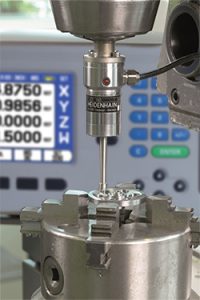Updated August 18, 2022
As automation continues to ramp up, pressure is increasing to make the most of spindle time. That puts a premium on fast and accurate setups and inspection. While relatively simple processes, manually zeroing out a workpiece or finding an edge can eat into spindle time, especially when that time is compounded over multiple parts and shifts.
Mechanical wigglers are one way to do it, but these can’t be connected to a readout or control. This sacrifices much of the potential time savings. With mechanical edge finders, the actual tool is often used instead of a probe which leads to variations in accuracy depending on the cutter and operator.
That’s what makes electronic edge finders an ideal tool for any machinist or operator who’s responsible for efficient and accurate machining. Our KT 130 Triggering Edge Finder can be used for both conductive and non-conductive materials, decreasing setup times and ensuring precise, repeatable positioning in a wide variety of jobs.
The stylus is deflected when it contacts the workpiece, and the edge finder sends a triggering signal over the connecting cable to the digital readouts or control. This spindle-mounted probe zeros on contact with a conductive workpiece, increasing operator speed and accuracy when establishing datum (workpiece zero). The 3D, spring-loaded probe records the located edge, even if over-travel should occur.
The KT 130 can provide edge-finding functions on some of our most popular products, including DRO300 digital readouts and the MILLPWR G2 two- or three-axis control and three-axis readout system.
Functions on MILLPWR G2 control systems:
- Locate datum (workpiece zero)
- Locate spindle center-relative to workpiece
- Teach positions
Functions on DRO 300 readout systems:
- All of the G2 functions plus…
- Measure inside and outside workpiece dimensions
- Center, measure or find the midpoint of holes/circular parts
The probe is mounted in the spindle and automatically zeros on contact with a conductive workpiece, increasing operator speed and accuracy when establishing datum. The 3D spring loaded probe records the located edge, even if over-travel should occur.
When used with an ACU-RITE readout, the following probing soft key functions are available:
- Workpiece edge as datum: EDGE soft key
- Centerline between two workpiece edges
- CENTER LINE soft key
- Center of a hole or cylinder
- CIRCLE CENTER soft key
In all probing functions, 200S takes into account the probe’s entered tip diameter. During probing functions, with an electronic, or grounding edge finder, the display freezes with the location of the edge, centerline, or circle center.

